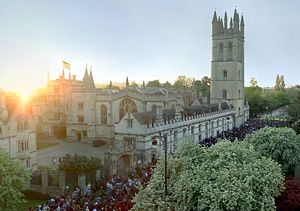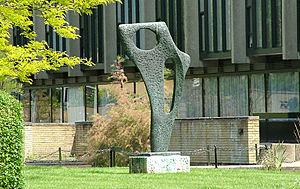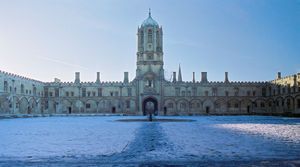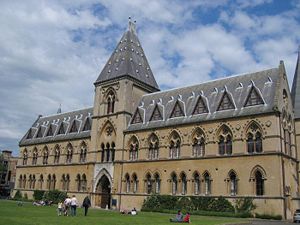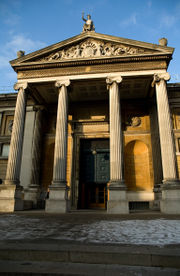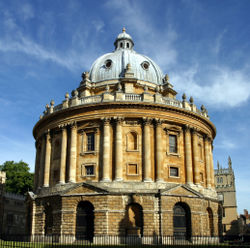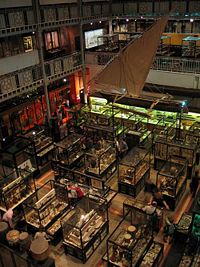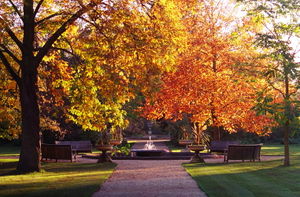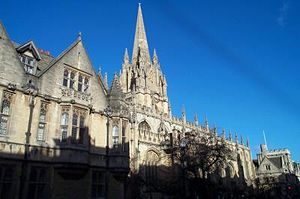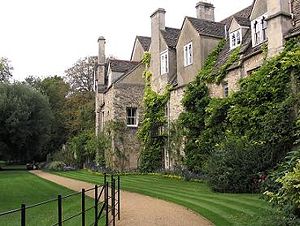University of Oxford
2008/9 Schools Wikipedia Selection. Related subjects: Education
| University of Oxford | |
|---|---|
 |
|
|
Latin: Universitas Oxoniensis |
|
| Motto: | Dominus Illuminatio Mea "The Lord is my Light" |
| Established: | Unknown, teaching existed since 1096 |
| Type: | Public |
| Endowment: | £3.6 billion (inc. colleges) |
| Chancellor: | The Rt Hon. Baron Patten of Barnes |
| Vice-Chancellor: | Dr John Hood |
| Students: | 18,431 (2006) |
| Undergraduates: | 11,185 (2006) |
| Postgraduates: | 6,768 (2006) |
| Location: | Oxford, Oxfordshire, England |
| Colours: | Oxford (dark) blue |
| Affiliations: | IARU Russell Group Coimbra Group Europaeum EUA LERU 'Golden Triangle' |
| Website: | ox.ac.uk |
 |
|
The University of Oxford (informally "Oxford University"), located in the city of Oxford, England, is the oldest university in the English-speaking world. It is also regarded as one of the world's leading academic institutions. (The name is sometimes abbreviated as Oxon. in post-nominals, from the Latin "Oxoniensis".)
The university traces its roots back to at least the end of the 11th century, although the exact date of foundation remains unclear. After a dispute between students and townsfolk broke out in 1209, some of the academics at Oxford fled north-east to the town of Cambridge, where the University of Cambridge was founded. The two universities have since had a long history of competition with each other (see Oxbridge rivalry).
The University of Oxford is a member of the Russell Group of research-led British universities, the Coimbra Group (a network of leading European universities), the League of European Research Universities, and is also a core member of the Europaeum. Academically, Oxford is consistently ranked in the world's top ten universities. For more than a century, it has served as the home of the Rhodes Scholarship, which brings highly accomplished students from a number of countries to study at Oxford as postgraduates.
History
The town of Oxford was already an important centre of learning by the end of the 12th century. Teachers from mainland Europe and other scholars settled there, and lectures are known to have been delivered by as early as 1096. The expulsion of foreigners from the University of Paris in 1167 caused many English scholars to return from France and settle in Oxford. The historian Gerald of Wales lectured to the scholars in 1188, and the first known foreign scholar, Emo of Friesland arrived in 1190. The head of the University was named a chancellor from 1201, and the masters were recognised as a universitas or corporation in 1231. The students associated together, on the basis of geographical origins, into two “ nations”, representing the North (including the Scots) and the South (including the Irish and the Welsh). In later centuries, geographical origins continued to influence many students' affiliations when membership of a college or hall became customary in Oxford. Members of many religious orders, including Dominicans, Franciscans, Carmelites, and Augustinians, settled in Oxford in the mid-13th century, gained influence, and maintained houses for students. At about the same time, private benefactors established colleges to serve as self-contained scholarly communities. Among the earliest were John de Balliol, father of the future King of Scots; Balliol College bears his name. Another founder, Walter de Merton, a chancellor of England and afterwards Bishop of Rochester, devised a series of regulations for college life; Merton College thereby became the model for such establishments at Oxford as well as at the University of Cambridge. Thereafter, an increasing number of students forsook living in halls and religious houses in favour of living at colleges.
The new learning of the Renaissance greatly influenced Oxford from the late 15th century onward. Among university scholars of the period were William Grocyn, who contributed to the revival of the Greek language, and John Colet, the noted biblical scholar. With the Reformation and the breaking of ties with the Roman Catholic Church, the method of teaching at the university was transformed from the medieval Scholastic method to Renaissance education, although institutions associated with the university suffered loss of land and revenues. In 1636, Chancellor William Laud, archbishop of Canterbury, codified the university statutes; these to a large extent remained the university's governing regulations until the mid-19th century. Laud was also responsible for the granting of a charter securing privileges for the university press, and he made significant contributions to the Bodleian Library, the main library of the university.
The university was a centre of the Royalist Party during the English Civil War (1642–1649), while the town favoured the opposing Parliamentarian cause. Soldier-statesman Oliver Cromwell, chancellor of the university from 1650 to 1657, was responsible for preventing both Oxford and Cambridge from being closed down by the Puritans, who viewed university education as dangerous to religious beliefs. From the mid-18th century onward, however, the University of Oxford took little part in political conflicts.
Administrative reforms during the 19th century included the replacement of oral examinations with written entrance tests, greater tolerance for religious dissent, and the establishment of four colleges for women. Women have been eligible to be full members of the university and have been entitled to take degrees since 1920. Although Oxford's emphasis traditionally had been on classical knowledge, its curriculum expanded in the course of the 19th century and now attaches equal importance to scientific and medical studies.
The list of distinguished scholars at the University of Oxford is long and includes many who have made major contributions to British politics, the sciences, medicine, and literature. More than forty Nobel laureates and more than fifty world leaders have been affiliated with the University of Oxford. Since its foundation in 1823, the Oxford Union, a private club devoted to formal debating and other social activities, has numbered among its members many of Britain's most noted political leaders.
Organisation
As a collegiate university, Oxford's structure can be confusing to those unfamiliar with it. The university is essentially a federation: it comprises over forty self-governing colleges and halls, along with a central administration headed by the Vice-Chancellor. The academic departments are located centrally within this structure; they are not affiliated to any particular college. The departments perform research, provide facilities for teaching and research, organise lectures and seminars, and determine the syllabi and guidelines for the teaching of students. Colleges then organise the tutorial teaching for their undergraduates. The members of an academic department are spread around many colleges; though certain colleges do have subject strengths (e.g. Nuffield College as a centre for the social sciences), they are the exception, and most colleges will have a broad mix of academics and students from a diverse range of subjects. Facilities such as libraries are provided on all these levels: by the central university (the Bodleian), by the departments (individual departmental libraries, such as the English Faculty Library), and by colleges (all of which maintain a multi-discipline library for the use of their members).
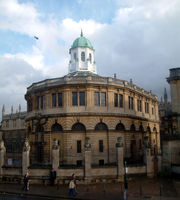
Central Governance
The university's formal head is the Chancellor (currently Lord Patten), though as with most British universities, the Chancellor is a titular figure, rather than someone involved with the day-to-day running of the university. Elected by the members of Convocation, a body comprising all graduates of the university, the Chancellor holds office until death.
The Vice-Chancellor, currently Dr John Hood, is the de facto head of the University. Five Pro-Vice-Chancellors have specific responsibilities for Education; Research; Planning and Resources; Development and External Affairs; and Personnel and Equal Opportunities. The University Council is the executive policy-forming body, which consists of the Vice-Chancellor as well as heads of departments and other members elected by Congregation, in addition to observers from the Student Union. Congregation, the ‘parliament of the dons’, comprises over 3,700 members of the University’s academic and administrative staff, and has ultimate responsibility for legislative matters: it discusses and pronounces on policies proposed by the University Council. Oxford and Cambridge (which is similarly structured) are unique for this democratic form of governance.
Two university proctors, who are elected annually on a rotating basis from two of the colleges, supervise undergraduate discipline. The collection of University Professors is called the Statutory Professors of the University of Oxford. They are particularly influential in the running of the graduate programmes within the University. Examples of Statutory Professors are the Chichele Professorships and the Drummond Professor of Political Economy. The various academic faculties, departments, and institutes are organised into four divisions, each with their own Head and elected board. They are the Humanities Division; the Social Sciences Division; the Mathematical, Physical and Life Sciences Division; and the Medical Sciences Division.
Colleges
There are 39 colleges of the University of Oxford and seven Permanent Private Halls, each with its own internal structure and activities. All students, and most academic staff, are affiliated with a college. The heads of Oxford colleges are known by various titles, according to the college, including warden, provost, principal, president, rector or master. The colleges join together as the Conference of Colleges to discuss policy and to deal with the central University administration. Teaching members of the colleges (fellows and tutors) are collectively and familiarly known as dons (though the term is rarely used by members of the university itself). In addition to residential and dining facilities, the colleges provide social, cultural, and recreational activities for their members. Colleges have responsibility for admitting undergraduates and organising their tuition; for graduates, this responsibility falls upon the departments.
Teaching and Degrees
Undergraduate teaching is centred upon the tutorial, where 1-4 students spend an hour with an academic discussing their week’s work, usually an essay (arts) or problem sheet (sciences). Students usually have around two tutorials a week, and can be taught by academics at any other college - not just their own - as expertise and personnel requires. These tutorials are complemented by lectures, classes and seminars, which are organised on a departmental basis. Graduate students undertaking taught degrees are usually instructed through classes and seminars, though naturally there is more focus upon individual research.
The university itself is responsible for conducting examinations and conferring degrees. The passing of two sets of examinations is a prerequisite for a first degree. The first set of examinations, called either Honour Moderations (‘Mods’ and ‘Honour Mods’) or Preliminary Examinations (‘Prelims’), are usually held at the end of the first year (or after five terms in the case of Classics). The second set of examinations, the Final Honour School (‘Finals’), is held at the end of the undergraduate course. Successful candidates receive first-, upper or lower second-, or third-class honours based on their performance in Finals. Research degrees at the master's and doctoral level are conferred in all subjects studied at graduate level at the university.
Academic Year
The academic year is divided into three terms, determined by Regulations. Michaelmas Term lasts from October to December; Hilary Term from January to March; and Trinity Term from April to July.
Within these terms, Council determines for each year eight-week periods called Full Terms, during which undergraduate teaching takes place. These terms are shorter than those of many other British universities. Undergraduates are also expected to prepare heavily in the three vacations (known as the Christmas, Easter and Long Vacations).
Internally at least, the dates in the term are often referred to by a number in reference to the start of each full term, thus the first week of any full term is called "1st week" and the last is "8th week". The numbering of the weeks continues up to the end of the term, and begins again with negative numbering from the beginning of the succeeding term, through "minus first week" and "noughth week", which precedes "1st week". Weeks begin on a Sunday.
Finances
In 2005/06 the University had income of £609m, and the colleges £237m (of which £41m is a flow-through from the University). For the University, key sources were HEFCE (£166m) and research grants (£213m). For the colleges, the largest single source was endowments and interest (£82m) and residential charges (£47m). While the University has the larger operating budget, the colleges have a far larger aggregate endowment, at around £2.7bn compared to the University's £900m.
Admission
Procedure
The admission process for undergraduates is undertaken by the individual colleges, working with each other to ensure that the best students gain a place at the University regardless of whether they are accepted by their preferred college. Selection is based on achieved and predicted exam results; candidate-submitted written work; interviews, which are held between applicants and college tutors; and, in some subjects, written admission tests prior to interview. Personal statements and school references are also considered. Prospective students apply through the UCAS application system, in common with all British universities, but (along with applicants for Cambridge) must observe an earlier deadline. They must also complete an additional, Oxford-specific form. Because of the high volume of applications and the direct involvement of the faculty in admissions, students are not permitted to apply to both Oxford and Cambridge in the same year, with the exception of applicants for Organ Scholarships and those applying to read for a second undergraduate degree.
The decentralised, college-based nature of the admissions procedure necessitates a number of mechanisms to ensure that the best students are offered admission to the University, regardless of whether the college they originally applied to can accommodate them. As such, colleges can 'pool' candidates to other colleges, whereby candidates can be interviewed at and/or offered admission to another college. Some applicants are also awarded an 'open offer', which does not carry an attachment to a particular college until A Level results day in August. The colleges have recently signed up to what they call a 'common framework' outlining the principles and procedures they observe.
For graduate students, admission is first by the relevant department, and then by a college.
Access
Despite the University's claims that its admissions policies avoid bias to candidates of certain socioeconomic or educational backgrounds, the fairness of Oxford admissions have continued to attract considerable public controversy through episodes such as the Laura Spence Affair in 2000. Although the University puts enormous efforts into attracting working-class students, Oxbridge entrance remains a central focus for many private and selective-state schools, and the under-representation of comprehensive school pupils remains a point of controversy. In 2007, the University refined its admissions procedure to take into account the academic performance of applicants' schools.
Students who apply from state schools and colleges have a comparable acceptance rate to those from independent schools (25% and 32% of applicants accepted respectively, 2006). However, most pupils who are accepted from state schools come from "elite" grammar and selective schools, rather than comprehensives. Only about half of applications come from the state sector, and the University of Oxford funds many initiatives to attract applicants from this sector, including the Oxford Access Scheme, Target Schools, and the FE Access Initiative. Most colleges also run their own access schemes and initiatives.
The University is also open to overseas students (primarily from American universities) who may enrol in study abroad programmes during the summer months. Mature and part-time students are supported by the Oxford University Department for Continuing Education.
Scholarships and Financial Support
There are many opportunities for students at Oxford to receive financial help during their studies. The Oxford Opportunity Bursaries, introduced in 2006, are university-wide means-based bursaries available to any British undergraduate. With a total possible grant of £10,235 over a 3-year degree, it is the most generous bursary scheme offered by any British university. In addition, individual colleges also offer bursaries and funds to help their students. For graduate study, there are many scholarships attached to the University, available to students from all sorts of backgrounds, from the famous Rhodes Scholarships to the new Weidenfeld Scholarships. In October 2007, it was announced that Oxford would be launching a fund-raising campaign with a goal in excess of £1 billion. Of the money raised, approximately one quarter is expected to go towards student financial support.
Students successful in early examinations are rewarded by their colleges with scholarships and exhibitions, normally the result of a long-standing endowment, although when tuition fees were first abolished, the amounts of money available became purely nominal. Scholars, and exhibitioners in some colleges, are entitled to wear a more voluminous undergraduate gown; "commoners" (originally those who had to pay for their "commons", or food and lodging) being restricted to a short, sleeveless garment. The term "scholar" in relation to Oxbridge, therefore, had a specific meaning as well as the more general meaning of someone of outstanding academic ability. In previous times, there were "noblemen commoners" and "gentlemen commoners", but these ranks were abolished in the 19th century. "Closed" scholarships, which were accessible only to candidates who fitted specific conditions such as coming from specific schools, exist now only in name.
Until 1866 one had to belong to the Church of England to receive the BA degree from Oxford, and "dissenters" were only permitted to receive the MA in 1871. Knowledge of Ancient Greek was required until 1920, and Latin until 1960. Women were admitted to degrees in 1920.
Collections
Libraries
Oxford’s central research library is the Bodleian, founded by Sir Thomas Bodley in 1598 and opened in 1602. With over 8 million volumes housed on 117 miles of shelving, it is the second-largest library in the UK, after the British Library. It is a legal deposit library, which means that it is entitled to request a free copy of every book published in the UK. As such, its collection is growing at a rate of over three miles (five kilometres) of shelving every year. Its main central site consists of the Radcliffe Camera, the Old Schools Quadrangle, the Clarendon Building, and the New Bodleian Building. A tunnel underneath Broad Street connects the buildings. There are plans to build a new book depository in Osney Mead, and to remodel the New Bodleian building to better showcase the library’s various treasures (which include a Shakespeare First Folio and a Gutenberg Bible) as well as temporary exhibitions. Several other libraries, such as the Radcliffe Science Library and the Oriental Institute Library, also fall within the Bodleian Group’s remit.
As well as the Bodleian, there are a number of other specialised libraries in Oxford, such as the Sackler Library which holds classical collections. In addition, most academic departments maintain their own library, as do all colleges. The University’s entire collection is catalogued by the Oxford Libraries Information System, though with such a huge collection, this is an ongoing task. Oxford University Library Services, the head of which is Bodley’s Librarian, is the governing administrative body responsible for libraries in Oxford. The Bodleian is currently engaged in a mass-digitisation project with Google.
- See also: Category:Libraries in Oxford
Museums
Oxford maintains a number of museums and galleries in addition to its libraries. The Ashmolean Museum, founded in 1683, is the oldest museum in the UK, and the oldest university museum in the world. It holds significant collections of art and archaeology, including works by Michelangelo, Leonardo, Turner, and Picasso, as well as treasures such as the Parian Marble and the Alfred Jewel. The Ashmolean is currently undertaking a £49m redevelopment which will double the display space as well as provide new facilities.
The Museum of Natural History holds the University’s anatomical and natural history specimens. It is housed in a large neo-Gothic building on Parks Road, in the University’s Science Area. Among its collection are the skeletons of a Tyrannosaurus rex and triceratops, and the most complete remains of a dodo found anywhere in the world. It also hosts the Simonyi Professorship of the Public Understanding of Science, currently held by Richard Dawkins.
Adjoining the Museum of Natural History is the Pitt Rivers Museum, founded in 1884, which displays the University’s archaeological and anthropological collections, currently holding over 500,000 items. It recently built a new research annexe; its staff have been involved with the teaching of anthropology at Oxford since its foundation, when as part of his donation General Augustus Pitt Rivers stipulated that the University establish a lectureship in anthropology.
The Museum of the History of Science is housed on Broad St in the world’s oldest-surviving purpose-built museum building. It contains 15,000 artifacts, from antiquity to the 20th century, representing almost all aspects of the history of science. In the Faculty of Music on St Aldate's is the Bate Collection of Musical Instruments, a collection mostly comprising of instruments from Western classical music, from the medieval period onwards. The Botanic Garden is the oldest botanic garden in the UK, and the third-oldest scientific garden in the world. It contains representatives from over 90% of the world’s higher plant families. Christ Church Picture Gallery holds a collection of over 200 old master paintings.
- See also: Category:Museums in Oxford
Reputation
In the subject tables of the Times Good University Guide, Oxford's Physiological Sciences course is ranked first of 48 'Anatomy and Physiology' courses. Fine Art, Business Studies, Materials technology, Middle Eastern and African Studies, Music, Philosophy, and Politics, are also first and Education and Linguistics share first with Cambridge. Oxford comes second after Cambridge in a further seventeen subjects, and second after the University of Durham in English. The University then takes three third-places and an equal-third, as well as a fourth, fifth, and equal-sixth place in one subject each.
In the Guardian's subject tables for institutions in tariff-band 6 (universities whose prospective students are expected to score 400 or more tariff points) Oxford took first place for Anatomy and Physiology, Anthropology, Biosciences, Business and Management Studies, Earth and Marine Sciences, Economics, Law, Materials and Mineral Engineering, Modern Languages, Music, Politics, Psychology, and Sociology. Oxford came second to Cambridge in Archaeology, Classics, English, History, History of Art, Mathematics, Philosophy, Theology and Religious Studies. Oxford came second to Aberdeen in General Engineering, and third in Fine Art, General Engineering and Physics; fourth place in Chemistry and Medicine; sixth place in Computer Science and IT.
Oxford is one of four UK universities that belong to the Coimbra Group, one of four UK universities that belong to the League of European Research Universities, and one of three UK universities that belong to both. It is the only UK university to belong to the Europaeum group.
League Table Rankings
| 2008 | 2007 | 2006 | 2005 | |
|---|---|---|---|---|
| Times Good University Guide | 1st | 1st | 1st | |
| Guardian University Guide | 1st | 2nd | 1st | |
| Sunday Times University Guide | 2nd | 2nd | 2nd | |
| Daily Telegraph | 2nd |
| 2007 | 2006 | 2005 | 2004 | 2003 | |
|---|---|---|---|---|---|
| THES - QS World University Rankings | 2nd | 3rd | 4th | 5th | N/A |
| Academic Ranking of World Universities | 10th | 10th | 10th | 8th | 9th |
Notable alumni and academics
There are many famous Oxonians, as alumni of the University are known:
25 British Prime Ministers have attended Oxford (including William Gladstone, Herbert Asquith, Clement Attlee, Harold Wilson, Margaret Thatcher and Tony Blair). At least 25 other international leaders have been educated at Oxford. This number includes King Harald V of Norway, King Abdullah II of Jordan, three Prime Ministers of Australia ( John Gorton, Malcolm Fraser and Bob Hawke) two Prime Ministers of India ( Manmohan Singh and Indira Gandhi) Zulfiqar Ali Bhutto and Benazir Bhutto of Pakistan, Norman Washington Manley (Chief Minister of Jamaica), and Bill Clinton, the first American President to attend Oxford. The Burmese democracy activist and Nobel Laureate Aung San Suu Kyi was a student of St Hugh's College. Including Aung San Suu Kyi, 47 Nobel prize winners have studied or taught at Oxford.
Oxford has also produced at least 12 saints and 20 Archbishops of Canterbury, including the current incumbent Rowan Williams (who studied at Wadham College and was later a Canon Professor at Christ Church. At least nine Olympic medal winners have academic connections with the university, including Sir Matthew Pinsent, quadruple gold medallist rower. T. E. Lawrence was a student at Jesus College, while other illustrious members have ranged from the explorer, courtier, and man of letters Sir Walter Raleigh (who attended Oriel College, though left without taking a degree) to the media magnate Rupert Murdoch. The founder of Methodism, John Wesley, studied at Christ Church and was elected a fellow of Lincoln College.
Amongst the long list of writers associated with Oxford are Evelyn Waugh, Lewis Carroll, Aldous Huxley, Oscar Wilde, C.S. Lewis, J.R.R. Tolkien, Graham Greene, Phillip Pullman, Vikram Seth and Plum Sykes, the poets Percy Bysshe Shelley, John Donne, A. E. Housman, W. H. Auden, and Philip Larkin, and Poets Laureate Thomas Warton, Henry James Pye, Robert Southey, Robert Bridges, Cecil Day-Lewis, Sir John Betjeman, and Andrew Motion.
Some contemporary scientists include Stephen Hawking, Richard Dawkins and Nobel prize-winner Anthony James Leggett, and Tim Berners-Lee, co-inventor of the World Wide Web.
Actors Hugh Grant, Kate Beckinsale, Dudley Moore, Michael Palin, and Terry Jones were undergraduates at the University, as were Oscar winner Florian Henckel von Donnersmarck and film-maker Ken Loach.. Sports. Imran Khan also studied at Oxford.
More complete information on famous senior and junior members of the University can be found in the individual college articles (an individual may be associated with two or more colleges, as an undergraduate, postgraduate, and/or member of staff).
Affiliates and other institutions
Well-known organisations and institutions officially connected with the University include:
Departments
- See: Category:Departments of the University of Oxford
Clubs and societies
- Oxford University Student Union
- Oxford Union Society (debating society)
- Oxford University Dramatic Society
- Oxford University Boat Club (rowing club participating in the Boat Race)
- Oxford University RFC (rugby club participating in the Varsity Match)
- Oxford University A.F.C. (association football club)
- Category:Oxford student societies
- Category:Oxford student sports clubs
Buildings and parks
- Sheldonian Theatre
- Tom Tower
- Radcliffe Camera
- University Church of St Mary the Virgin
- Christ Church Cathedral, Oxford
- Oxford University Parks
- Oxford Botanic Garden and Harcourt Arboretum
- Rhodes Trust, the centre of the Rhodes Scholarship
- Category:Buildings and structures in Oxford
- Category:Churches in Oxford
- Category:Parks and open spaces in Oxford
Other institutions
There are other higher and further education institutions in Oxford, including various independent "colleges", not associated with the University. These include Oxford Brookes University; Ruskin College, Oxford - an adult education college - which, although not part of the University of Oxford, has close links with it; and the former Lady Spencer Churchill teaching college (now the Wheatley campus of Oxford Brookes).
The University of Oxford is an Educational Alliance Partner of the Meade 4M Community which supports the University's 'Project Jetwatch' program.


